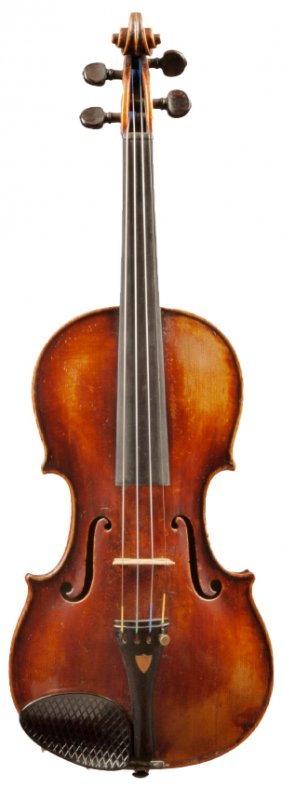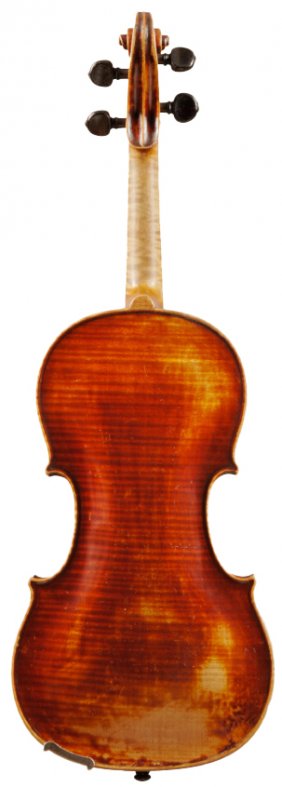Mathias Albani is a fascinating and mysterious maker of the old Tyrolean school, whose influence on some of the greatest Italian luthiers should not be underestimated. His authenticated work is subtle and beautifully proportioned, with a varnish that is quite equal to the best of the Venetians. It owes nothing to Stainer, but much to the Amati, yet is still entirely personal and distinctive.
He was born in St Nikolaus in Kaltern, a village on the northern shore of the Kaltern lake in southern Tyrol 1621, but at some early stage moved a short distance north to Bozen. The region was at that time Austrian, and remained so until the end of the First World War. It is now Italian, and the towns have dual names; Kaltern is Caldaro in Italian, and Bozen is also known as Bolzano. It is a lushly forested area, with ample supplies of the tone wood which made the whole Tyrol such fertile ground for instrument makers in the sixteenth and seventeenth centuries. A little to the north of Bozen is Bressanone, the birthplace of Matteo Gofriller. Jacob Stainer's birthplace, Absam lies further north and Brescia is roughly an equal distance to the south. The link between these towns is the Brenner Pass, the most important trading link through the alps since Roman times.


Jacob Stainer and Albani were exact contemporaries, both born in 1621. While Stainer was well into his stride by 1640, and set to become the most influential of German-speaking makers, there is no account of Albani's early life. The major problem is that his labels have been often counterfeited, and those dated prior to 1690 come under especially strong suspicion. What is known is that he married late in life, in 1671, and had two sons, Michael and Joseph, who both became fine makers in their own right.
Where and how Albani learned his craft is a matter for conjecture, but presumably within the same culture that Stainer inhabited. In the first half of the seventeenth century there was really only one model for violin makers to follow, and that was Amati. There are some interesting technical points about the construction Albani employed. Like Amati and Stainer he morticed his linings into the corner blocks, a procedure usually associated with the use of a Cremonese-like internal mould. Unlike them however, he tended to use a tapered joint, with points cut on the end of the linings sliding into knife-cut slits in the block. This style of work, subtly different from the squared mortice joint used by the Cremonese, is seen in many subsequent Tyrolean makers. The interior work is done with a soft hardwood, poplar or willow, another contrast to most other makers who tended to use pine in this period, Stradivari excepted. The outline is generally a good match for the smaller Amati model, implying that Albani's experience was with the work of the brothers, Antonio and Hieronymus, whose instruments were almost certainly travelling along the Brenner pass to clients all over Europe. This choice of pattern does however slightly limit the tonal potential of Albani instruments, the voice being in the silvery range rather than the deep and powerful sound of larger-bodied Cremonese instruments.
For the main parts of the instrument, Albani's wood choice generally leans toward two piece backs of maple with a narrow figure, and fronts of exceedingly close grained spruce. The spruce forests were very local to him, and he was presumably able to take first choice of the best cuts.
The purfling is very conventional, beautifully laid in, a trifle wide and with the long points evenly placed in the centre of rather short corners. The edge is slender but deeply channelled and perfectly moulded. The arching is generally of medium height, but a little boxy compared with the supple rounded forms of the Amati. He does seem to have used fixing pins beneath the purfling at the upper and lower blocks, but they are usually very small and almost undetectable.
The soundholes are very well placed on the table, extremely Cremonese in appearance, sometimes a little broad, but evidently copied carefully from Amati originals.
The neatness and precision of Albani's work is carried through to the scroll, which is a perfect example of concentricity and balance. Sometimes the eye has a slightly exaggerated tail, an idiosyncracy that Stainer adapted into a trademark, and which became the model for subsequent generations of German luthiers. The proportions of the pegbox, and front and rear views of the scroll are uncannily Cremonese.
The most eye-catching aspect of these consistently beautifully made instruments is however the varnish. The deep red colour, rich golden yellow ground and crackled texture makes immediate and obvious connections to the varnish of Montagnana. It often takes a long hard look to distinguish the two makers, but Albani belonged to an earlier generation of luthiers. It is evident that this rich, oily varnish was known to Tyrolean makers before it reached Venice, and was probably introduced by Matteo Gofriller who moved there from Bressanone in 1685.
Albani took from Cremona the important aspects of craftsmanship and design, but gave back the red colouration that marked out the eighteenth century work of Stradivari, Guarneri and the Venetian masters, a vivid contrast to the muted golden brown of sixteenth century Cremona. His most direct influence was on his sons, Michael and Joseph, but also on the Jais family, who also worked in Bozen. The Stainer model, clothed in a very Albani-like clotted red varnish is recognisable in the work of countless Mittenwald-trained makers, and is the archetype of German violin making in the eighteenth century. It is unfortunate that Albani's name was subsequently traduced by the horde of cheaply made instruments from that region that were opportunistically given his label. The violin dictionaries list many makers with the Albani family name, and much confusion about the dates and lineage. In truth, many of them were simply made up for false labels. Mathias is the genuine article, and an extremely fine violin maker.